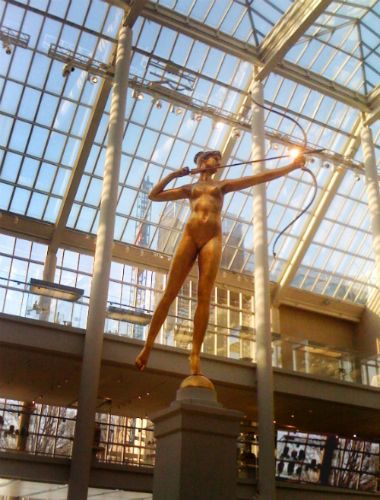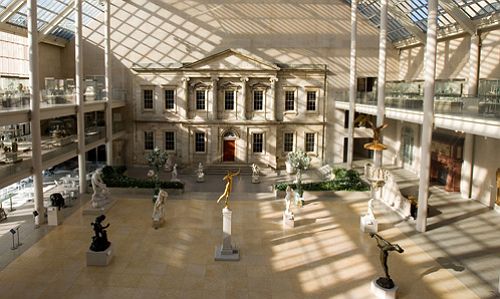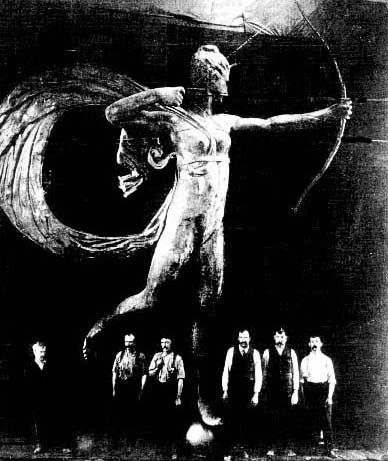
Diana, 1892–93;
This cast, 1928
Augustus Saint-Gaudens (American, 1848–1907)
Bronze, gilt
Metropolitan Museum of Art, New York

The Charles Engelhard Court
The American Wing
The Metropolitan Museum of Art, New York
-------------------------------------------------------------------------------------------------------------------------------------------------------------
Article Below:
Augustus Saint-Gaudens (1848-1907)
Diana of the Tower ca. 1899-1907
By: Thayer Tolles*
In: American dreams: American art to 1950 in the
Williams College Museum of Art
Hudson Hills Press, Oct 5 2001. Pp102-105
*Tolles is a graduate of Williams College (1987)
And Assistant Curator
Department of American Painting and Sculpture
The Metropolitan Museum of Art
For late-nineteenth-Beaux-Art sculptors a skillfully rendered nude was paramount demonstration of artistic competence. Rigorously schooled in Parisian academics, these artists drew and modeled sketches of the nude, aspiring to translate their talents into finished works with ideal themes. Of subjects inspired by classical mythology, Diana, goddess of the chase and the moon. was favored by sculptors from Jean Antoine Hondon to Jean-Alexandre-Joseph Falguiere, French-trained Americans such as Augustus Saint-Gaudens, Frederick William MacMonnies, and Olin Levi
Warner, were similarly drawn to her ideal feminine beauty. One reason for this popularity was that her understated attributes - bow, arrow, and crescent moon headpiece - so effectively asserted her identity that sculptors were able to give visual prominence to her nudity and thus showcase their prowess at modeling the human form. Although Diana was the only Saint-Gaudens sculpted during his illustrious career, it enjoyed instant renown and remained a cornerstone of his oeuvre.
The William College Museum of Art's graceful rendering of Diana drawing her bow is a reduction after a monumental weathervane that once surmounted the tower of New York's Madison Square Garden (an indoor sporting arena, auditorium, and concert hall completed in 1891). Saint-Gaudens created the figure as "purely a labor of love" at the request of his close friend Stanford White, the architect of this Spanish Renaissance-style structure inspired by the tower of the tower of Giralda in Seville. White - a partner in the noted firm McKim, Mead, and White -often collaborated with Saint-Gaudens to create decorative pedestals and frames; joint efforts such as the Farragut Monument (1877—80, Madison Square Park, New York) and Bessie Smith White (1884, The Metropolitan Museum of Art, New York) are exemplars of the American Renaissance Aesthetic.
The initial seeds for Diana were sown in 1886 when Saint-Gaudens sculpted a portrait bust of his model and mistress Davida Johnson Clark (marble bust, Saint-Gaudens National Historic Site, Cornish, N.H.). This likeness later served as a study for the head of Diana, from which small figural studies were mechanically enlarged to an ambitious eighteen-foot-high figure by the W. H. Mullins manufacturing company in Salem, Ohio. When the statue of gilded copper sheets was hoisted atop the tower of Madison Square Garden in October 1891, it instantly became the point of greatest elevation in New York. With its clean lines and vivid silhouette, Diana gleamed in the light of day and was dramatically illuminated at night. However, her tenure atop the tower was short-lived; both architect and sculptor felt its scale was disproportionately large for its site. Furthermore, the immense weight - eighteen hundred pound - and awkward positioning of the left foot on the spherical base prevented the sculpture from revolving, thereby negating its function as a weathervane. Saint-Gaudens and White determined to create a smaller, lighter and more streamlined version at their own expense.

First weathervane version, bronze, photographed in the [Ohio] foundry,
Historic photograph collection of Saint-Gaudens National Historic Site
The first Diana (no longer extant) was removed in 1892 and sent to Chicago for display at the 1893 World's Columibian Exposition atop the Agricultural Building. Saint-Gaudens remodeled the figure, adjusting the hair, drapery and mounts as well as eliminating the crescent headpiece. When the slimmer, thirteen-foot figure was installed in November 1893, the critic Royal Cortissoz wrote appreciatively of the transformation: "The lithe goddess now has movement and elasticity as well as dignity; there is more strength in her limbs than there was, and there is more grace." Like the first Diana, the reworked figure featured a rudder of flying drapery to catch the wind. Unfortunately, when strong gales blew this piece off, the sculpture had to be permanently bolted into a stationary position. A famous New York landmark despite ongoing controversy over the issue of nudity, Diana remained resplendent on her perch until 1925, when Madison Square Garden was demolished. Seven years later, the New York Life Insurance Company, owners of the Garden site, gave the piece to the Philadelphia Museum of Art, where it is situated prominently at the top of a staircase.
By the time Saint-Gaudens modeled Diana for Madison Square Garden, he had revolutionized the field of American sculpture through his masterful handling of the bronze medium, his stirring monuments, and character-penetrating portrait reliefs. However, he, like other American sculptors, had been unable to encourage sustained interest for their bronze statuettes to the same degree artists enjoyed in France, for instance with the animal sculptures of Antoine-Louis Barye. Saint-Gaudens's replication of Diana as a statuette was a calculated attempt to bridge the gap between his large-scale images and smaller bronzes created for domestic display. During the 1890s and beyond, he successfully marketed multiple casts of three of his most attractive efforts: first Diana, then Robert Louis Stevenson and The Puritan. Ever concerned about maintaining control over the artistic process, he assured the individual aesthetic integrity of each cast by making occasional refinements, remodeling by hand rather than mechanically. He also experimented with the coloration of the patinas, which ranged from gold to green to brown. Copyrighted in January 1895, replicas of Diana were sold through Tiffany and Co. in New York, Doll and Richards in Boston, and by the sculptor himself.
When Saint-Gaudens reduced Diana, he made several changes from the original oversize figure. One, the removal of the billowing drapery. was the most significant compositional alteration; others, such as ongoing refinements to the hair, bow and base were more subtle, intended to improve the overall aesthetic. The earlier reductions, cast by Aubry Brothers in New York, are thirty-one inches high, and mounted on a half sphere (example in the collection of Chesterwood, National Trust for Historic Preservation, Mass.). Saint-Gaudens then produced a twenty-one-inch figure poised atop full orb on a low two-tiered base (example in the collection of the MetropolitanMuseum of Art). This "small" Diana was cast by Gruet in Paris, the artist's foundry of choice.
Although the figure is the same height at the "small" version, Williams College's Diana represents a third variation on the reduction theme. While Saint-Gaudens was in Paris in 1899, he remodeled the base so that the nude surmounts a sphere balanced atop a tripod adorned with winged griffins and classicizing scrolls and rosettes. This alteration is particularly pleasing since the elongated taper of the base complements the elegant sweeping lines of the nude.
Both French and American foundries produced this third version. The bronzes were in existence as early as 1899, and casting continued after Saint-Gaudens's death in 1907. For these reasons, as well as the sculptor's incomplete records, it is not possible to determine an exact production date for Williams's Diana. The raised letters on the base may be read as "Diana Op the Tower" rather than "Diana Of the Tower," but this does not necessarily imply a foundry error, but rather a less crisply cut inscription.
Among other casts featuring the tripod base are those in the collection of the Cleveland Museum of Art; Gilcrease Museum, Tulsa Oklahoma; the New York Historical Society; and the Virginia Museum of Fine Arts, Richmond. A cast at the National Gallery of Art, Washington D.C., differs in the treatment of the hairstyle, while one at the Smith College Museum of Arts, Northampton, Massachusetts, has a knob on the side of the base which when turned causes the figure to rotate as did the original large-scale version.
-------------------------------------------------------------------------------------------------------------------------------------------------------------
Posted By: Kidist P. Asrat
-------------------------------------------------------------------------------------------------------------------------------------------------------------
